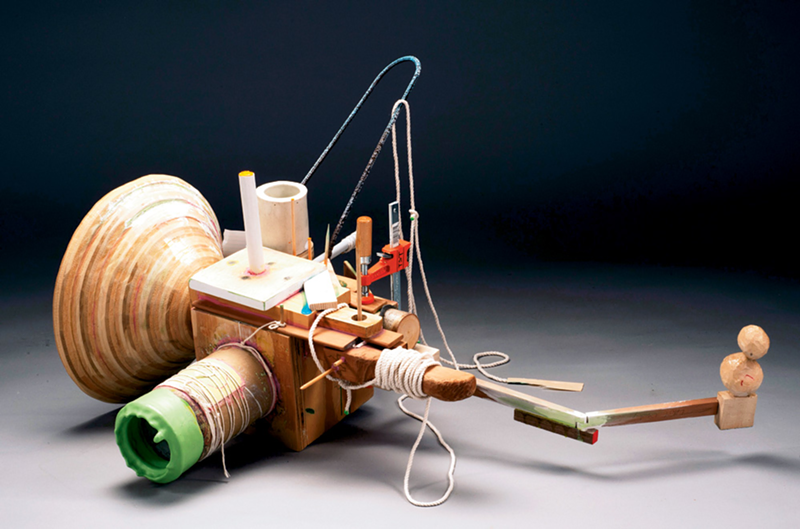M
anifest Creative Research Gallery and Drawing Center’s latest exhibition is the work of Travis Townsend in The Love Boat (abandoned), which is presented in conjunction with Out of the Gray, a group showing of works made using graphite.
Townsend’s work is in the first room of the gallery, while the group show is staged in both the rear Drawing Room and Manifest’s smaller, across-the-hall Parallel Space. While each exhibition demonstrates Manifest’s continued interest in the artist’s craft, the former’s solo work is particularly playful and experimental.
Townsend’s wooden, painted and drawn-upon, pieced-together sculptural objects inspire a close inspection, as he incorporates doodles, text, peepholes, open doorways and various apertures, inviting viewers for a closer look. With a look that is equal parts worked-over and undone, Townsend’s pieces have been altered three times (some over the course of a decade or more) and this reworking results in sculptural objects that resemble multiple things at once.
“Vehicle of Strange Conception (2000-2012)” is one such piece, in that it suggests disparate objects: a head-mounted camera rig, as well as a kind of post-apocalyptic Barbie house. Doll-size ladders are present throughout, intimating a hidden inhabitation by Lilliputians, and it lends a whimsical nature to Townsend’s work.
From one angle, “Vehicle” implies the box-within-a-box (screen-within-a-screen) lens of a professional video camera, while the adjacent frame appears to be a tiny room, replete with chair, dresser and art on the wall.
Regardless of vantage, Townsend’s work begs for examination and, because they’re on the floor, one often has to squat down or kneel like as if talking to a child, or proverbially “taking a load off” — and the effect can be disarming. I found myself squatting to get a better view while teetering on the balls of my feet, and serendipitous discoveries sent me off balance several times.
The exhibition’s title piece, “The Love Boat (abandoned) (2010-2012),” also includes the use of small ladders. The boat-like structure consists of two layered wood hulls coupled together, flying jib, mast and a flattop deck with a hatch. Peering down the narrow opening, a long ladder can be seen extending between the floor of the vessel and the hatch-like gap, alongside a pile of string that reaches across the gallery floor and forms the image of a bird in string-and-nail configuration on the wall. Little wooden lifeboats surround the sculpture as well as the corresponding wall-installation, and at the foot of the wall piece is a tiny dock-like structure on top of which is another ladder, above which lay a rope with a hoop — implying a flight and/or rescue narrative.
Throughout the exhibition, Townsend highlights elements of construction: He painted vice grips bright orange and a cylinder dipped in encaustic green; the artist reveals layers between wood in almost every piece with visible adhesive and dripping paint — emphasizing the impermanence of each structure’s configuration.
The fact that Townsend joins his work together in such temporary ways (glue, vice grips, bound with rope, etc.) is perhaps a visual metaphor for the temporality of these Mad Max-like structures. One imagines them as the last remnants of a race of tiny beings that fled some catastrophic event — so his emphasis on adaptation seems consistent with this line of narrative.
Comparatively, Manifest’s Out of the Gray is much more a staid exhibition, showcasing what one has come to expect from the self-titled Drawing Center: artists investigating craft. This particular exhibition focuses specifically on the limits and capabilities of graphite as a medium.
Two striking pieces in the first exhibition space (the Drawing Room, aptly enough) are Anthony Pessler’s “The River #1 & #4 (2009),” works of graphite on drafting film that have scratchy and almost blurred photographic negative looks to them. The two pieces figure the same horizon line and winding river connecting the bottom of the frame with the horizon and a sky virtually filled with hyper-realistic looking clouds. The heavens feature prominently in both compositions (cloud cover is nearly three-fourths of the frame) and the chiaroscuro Pessler employs to give a sense of depth and movement ranges from near-glowing white to pitch black.
Michelle-Marie Letelier’s “F60 – A Machine Too Big to Operate, #2 (2010)” is a graphite and oil on canvas work that was curiously conceived. At first glance the Berlin-based artist seems to have created a one-point perspective depiction of an industrial space (in this case a conveyor bridge that was taken out of operation after only 13 months of use due to new German energy policies), however, the artist’s use of materials is novel. By employing white oil paint and graphite (as a both texture and tone), in some places the graphite looks smooth — as if paint allowed it to soak straight into the weave of the canvas — and in other areas, it seems to sit in powdery chunks just on top.
There are several other artists in Out of the Gray who similarly work with graphite in unexpected ways. Lena Schmidt’s “Swinging Pods (2010)” is oversized, non-representational, was most likely painted on the floor (something to which the title may allude) and consists of graphite, charcoal and acrylic on paper.
Schmidt’s mark-making in “Pods” resembles the work of Asian calligraphists: sweeping brushwork that is spontaneous and irregular, which seems apt if we can assume that the title has anything to do with the work’s creation.
In perhaps the exhibition’s most striking piece, Marc Leone’s sculptural object hangs like a three-dimensional artwork on the wall of Manifest’s farthest gallery. The work, “Untitled 2, (2011)” is made of graphite, latex paint, earth, quartz and acids on canvas that was mounted on wood, and it looks like the surface of another planet. Like bubbling molten lava bursting out of charcoal embers, rivulets of black skin buckle and droop in a visible alchemy. From the look of it, I would hope Leone keeps a fire extinguisher in his studio handy. Just where the requisite graphite is exactly, in “Untitled 2,” I’m not sure … but the trip to look was definitely worth taking.
THE LOVE BOAT ABANDONED and OUT OF THE GRAY are on display through Feb. 24 at Manifest Creative Research Gallery in East Walnut Hills. Call 513-861-3638 or visit
www.manifestgallery.org for more information.






